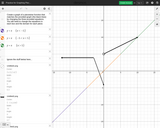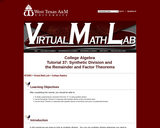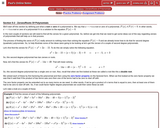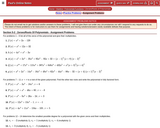
In this Khan Academy activity, students will determine when a polynomial function is positive or negative.
- Subject:
- Mathematics
- Material Type:
- Activity/Lab
- Provider:
- Khan Academy
- Date Added:
- 08/29/2018

In this Khan Academy activity, students will determine when a polynomial function is positive or negative.

Interactive resources that allows the user to manipulate characteristics of a piecewise function to graph.

The purpose of this task is tie together what students have learned about roots, end behavior, operations, and graphs of polynomials. Each problem gives a few features of a polynomial and asks students to find other features, sometimes including the graphs. This will require them to know the end behavior of a polynomial, based on the degree, and to find all the roots, given some of the roots. In most cases, students are asked to write the equation of the polynomial or to write the equation in a different form than is given.

overview goes here

This power point Explains the Remainder and Factor Theorems

This lesson unit is intended to help teachers assess how well students are able to translate between graphs and algebraic representations of polynomials. In particular, this unit aims to help you identify and assist students who have difficulties in: recognizing the connection between the zeros of polynomials when suitable factorizations are available, and graphs of the functions defined by polynomials; and recognizing the connection between transformations of the graphs and transformations of the functions obtained by replacing f(x) by f(x + k), f(x) + k, -f(x), f(-x).

This lesson unit is intended to help you assess how well students are able to translate between graphs and algebraic representations of polynomials. In particular, this unit aims to help you identify and assist students who have difficulties:
• Recognizing the connection between the zeros of polynomials when suitable
factorizations are available and graphs of the functions are defined by polynomials.
• Recognizing the connection between transformations of the graphs and transformations of the functions obtained by replacing f(x) by f(x + k), f(x) + k, -f(x), f(-x).

This tutorial covers dividing a polynomial by a binomial of the form x-c using synthetic division, using the Remainder Theorem in conjunction with synthetic division to find a functional value, and using the Factor theorem in conjunction with synthetic division to find factors and zeros of a polynomial function.

This lesson will teach students to factor trinomial expressions of the form x^2 + bx + c. Students will use algebra tiles to identify the binomial factors and the graphing calculator to verify the result. In addition, students will identify the x-intercepts and y-intercepts of each trinomial function and explore relationships between the trinomial x^2 + bx + c and its factored form (x + m)(x + n).

This website goes over what the zero of a polynomial is and connects the Fundamental Theorem of Algebra and Factor Theorem.

More problems using Fundamental Theorem of algebra

Practice problems using Fundamental Theorem of algebra

In this article, students learn about the relationship between the zeros, roots, x-intercepts of polynomials, and about zeros multiplicities.